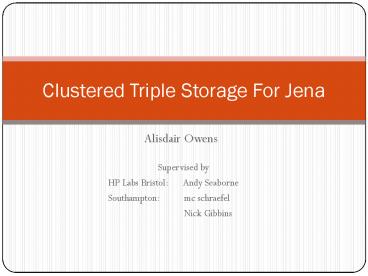Alisdair Owens PowerPoint PPT Presentation
1 / 27
Title: Alisdair Owens
1
Clustered Triple Storage For Jena
- Alisdair Owens
Supervised by HP Labs Bristol Andy
Seaborne Southampton mc schraefel Nick
Gibbins
2
Intro
- Requirement to store large amounts of RDF data
- Semantic Web
- Bioinformatics data
- Scaling RDF stores is difficult
- Flexibility of RDF does not lend itself to
efficient storage schemas - How can we scale up RDF storage?
3
Clustering!
- Apply the power of multiple machines to the
problem. - Standard approach in traditional Database
Management Systems (DBMS)
4
Outline
- Traditional RDF stores and the Jena Tuple
Database - Clustering Databases Concepts and Techniques
- Clustered TDB Design and Prototype Evaluation
- Questions
5
Storing RDF Triples
- RDF can be expressed as a table of triples
- Indexes allow simple selection by attribute
- SPO
- POS
- OSP
6
Typical Triple Store Architecture
7
Typical Triple Store
- Advantages
- Disadvantages
- Simple.
- Does not require the storage of large, variable
length strings in indexes. - No lookups required to convert RDF terms to
hashes.
- Expensive reads need to traverse index of node
table for every unique URI/literal returned. - Expensive writes need to traverse index of node
table and all B-trees for every write. - Large hash values necessary to prevent collisions.
8
TDB Architecture
9
TDB
- Advantages
- Disadvantages
- Fast writes.
- Reduces costs for NodeId to Node conversion.
- NodeIDs can be smaller than hashes, reducing the
size of SPO, POS, and OSP indexes.
- Potentially greater space required due to
additional Node/NodeID map. - Converting URIs/literals to IDs potentially costs
disk seeks, depending on how much we can keep in
memory.
10
Distributing Databases
- Apply the power of multiple machines to the
problem - Desired Improvements
- Speedup
- Scaleup
- Throughput Scaleup
11
Enabling Parallelism
- Partitioning
- Pipelining
- Concurrent Users and Subqueries
12
Barriers to Parallelisation
- Skew
- Startup
- Interference
13
Clustered TDB Objectives
- Provide a clustered triple store for Jena.
- Focus on lt100 machine systems.
- Support for useful and scalable read/write
performance. - Design with support for redundancy in mind.
14
Questions
- How do we
- Distribute information redundantly across the
cluster? - Allow rebalancing of data to deal with hot spots,
data changes, machine additions and removals? - Preserve TDBs performance characteristics?
- Scale in a near linear fashion?
- Optimise distributed queries?
15
Points of Interest
- How do we distribute each table/index?
- TDBs NodeIDs reference a disk location.
- How can these be extended to refer to a unique
location on the network? - Can we accomplish this while still allowing for
redundancy and redistribution? - Can we preserve append-only writes on the node
table? - How do we optimise queries?
16
Overall System Structure
17
Balancing
- To enable easy rebalancing, we pretend that our
100 machine cluster is comprised of (say) 2000
processing nodes. These are called virtual
processing nodes, or vnodes. - Vnodes 0-19 forward to machine 0, 20-39 to
machine 1, etc. - To rebalance, simply change the vnodes that each
machine is responsible for, and move data files
accordingly.
18
NodeIDs
- NodeIDs are unique 64 bit integers formed as
follows - Encodes the vnode and disk position of the
ID/node mapping. - Compressible.
19
Distributing the Node/NodeID Map
- Distribute the table based on hash value.
- High likelihood of even distribution.
- Inherent knowledge of data location.
20
Distributing the Node Table
- Distributed based on round robin (or other).
- Destination computers assign an ID to the node,
and transmit back to distributing node. - IDs encode their own location, so no need for
more complex distribution.
21
Distributing Triple Indexes
- Distributed three times based on a hash of S, P,
and O. - Each machine stores triples distributed on S in
its SPO index, P in POS, O in OSP. - Saves space, keeps indexes shorter.
- Inconsistent content in each index on a single
node. - Queries on individual machines make no sense.
22
Evaluation Load Times
- Scales in linear fashion with number of
processing nodes - Requires evaluation over larger number of machines
23
Evaluation Query Time
1 user
5 users
24
Evaluation Query Time
1 user
5 users
25
Conclusions
- Initial evaluations positive
- Excellent load scaling
- Query performance as expected
26
Ongoing discussion topics
- Statistics and Query Optimisation
- Distributing Operations
- Questions?
27
Take Away
- RDF stores have significant performance issues
- Distribution across multiple systems can
significantly improve performance. - Observations on distributing databases can be
applied to a wide range of distributed systems

